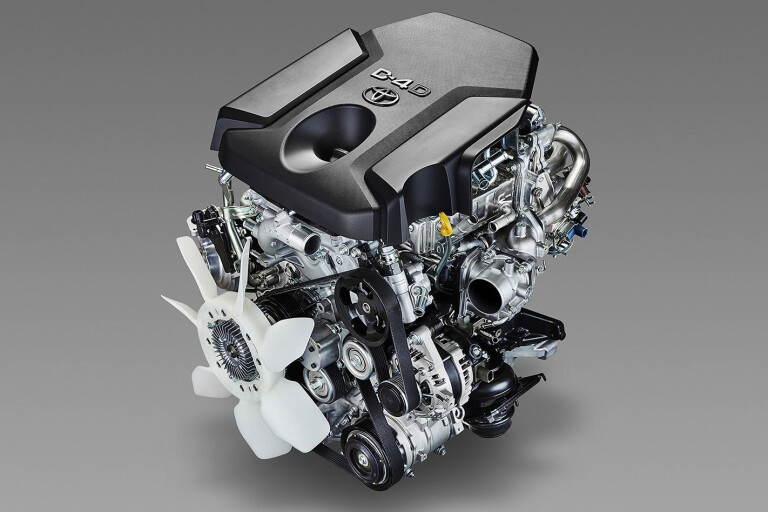
Toyota’s new 2.8-litre, four-cylinder diesel engine...
It's now in the Prado, the new Hilux and the Fortuner, and it offers a modest 3kW increase in peak power over the 3.0-litre engine it replaces.
Nevertheless, it is still a significant achievement.
Despite being eight per cent smaller in capacity, it produces 10 per cent more torque (now 450Nm; previously 410Nm) and more low- and middle-rpm power as a result.
But the smaller capacity is not the big efficiency story, as the new 2.8 engine’s 15.6:1 compression ratio is a significant 15 per cent lower than the 3.0-litre’s ratio of 17.9:1.
Compression ratio is a vital part of engine design. Higher compression ratios allow more mechanical energy to be extracted from the fuel being burnt and are a simple way to develop more power without increasing either engine speed or engine capacity.
The compression ratio of an engine is simply the volume of the cylinder when the piston is at the bottom of its stroke, compared to the volume of the cylinder when the piston is at the top of its stroke.
Increasing the compression ratio means the air-fuel mixture is squeezed into a smaller space, and when the mixture is ignited, higher pressures are applied to the piston.
This increased pressure on the piston provides more torque at the engine’s crankshaft (through the mechanical means of the conrod acting on the crankshaft’s big-end journal). That extra torque then produces more power.
In spark ignition (i.e. petrol) engines, compression ratios that are too high lead to pre-ignition (or detonation). This is where the fuel is ignited not by the spark plug, as it should be, but by the heat generated by the air being compressed, in what is an out-of-control and potentially engine-destroying explosion within the combustion chamber.
Diesel engines are designed to use the heat generated by compressing the air to ignite the fuel and have traditionally had high compression ratios. In fact, even as recently as 10 years ago, many 4x4 diesels had compression ratios up around 22:1 or even 23:1, a far cry from this new 2.8-litre’s 15.6:1.
Even though diesels are designed to have high compression ratios, and high compression ratios provide efficiency, it’s not all good news. A more forceful and violent explosion within the combustion chamber produces more noise in the form of diesel ‘knock’ and ‘rattle’, and potentially more engine vibration.
High compression ratios also produce more environmentally damaging oxides of nitrogen, commonly referred to as NOx; another reason why modern diesels are moving to lower compression ratios.
One thing that’s very obvious with this new 2.8 is that it’s much quieter and more refined than the outgoing 3.0-litre.
So how does a smaller engine with a lower compression ratio manage to make more power and torque than a bigger engine with a higher compression ratio, given that increasing an engine’s capacity and compression ratio is a straightforward way to increase torque and power?
The simple answer is that the 2.8 is more efficient at extracting energy from the fuel. Despite the lower compression ratios, the effective operating pressure within its cylinders is higher. This operating pressure is commonly called Brake Mean Effective Pressure (see ‘What is BMEP?’ sidebar).
The 2.8 achieves its higher BMEP despite a much lower compression ratio thanks largely to its common-rail fuel-injection system.
The common-rail system employed for Toyota’s new 2.8 engine runs at 2500bar, or around 35,000psi. That’s 1000 times what you put in your four-wheel drive’s tyres when they are pumped right up. Some common-rail systems use pressures as high as 3000bar.
The high fuel pressure means it takes less time to deliver the required fuel into the combustion chamber. Common-rail systems actually deliver the fuel to the combustion chamber in several small squirts rather than in one injection, as per older diesel engines.
The number and timing of these small, individual squirts of fuel depend on the load on the engine and on engine speed, and are designed to optimise flame propagation within the combustion chamber so the fuel is burnt most efficiently.
Interestingly, while European diesels commonly use very sophisticated piezo-electric injectors, Toyota’s 2.8-litre diesel uses more traditional electro-magnetic solenoid injectors, which are potentially less fuel-quality sensitive.
What is BMEP?
Brake Mean Effective Pressure (BMEP) is a measure of the operating pressure in an engine’s cylinders averaged out over the compression and power strokes. It’s a standard and handy measure of an engine’s “state of tune”. Highly tuned engines have high BMEP figures, while “soft-tune” engines have lower BMEP figures.
With any engine, if you increase the BMEP you will produce more power. Along with engine size and engine speed, BMEP defines how much power can be produced simply because more pressure on the piston will produce more torque at the crankshaft and therefore more power.
BMEP is a theoretical measure calculated from dynamometer-measured torque and is different from (although related to) measured cylinder pressure, commonly called Indicated Mean Effective Pressure, or IMEP.

COMMENTS